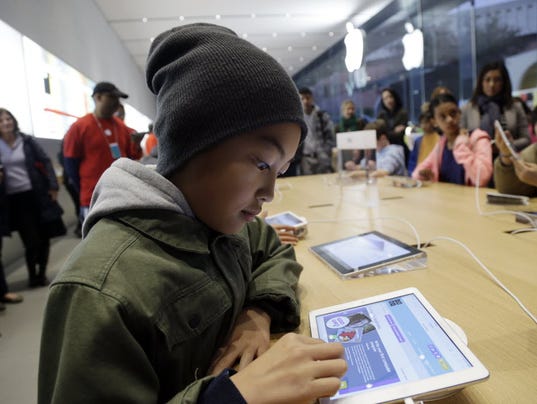SAN FRANCISCO — More kids than ever are going back to school this fall to learn something that just a few years ago they would never have been taught: computer science.
Code.org estimates those teachers will reach more than 600,000 students from kindergarten to 12th grade, many of whom are frequently overlooked by the tech industry: 43% are female and 37% are either African American or Latino.
Code.org is part of a national movement in education. Coding classes are popping up in high schools and in lower grades across the country. And those classes may have the potential to address unequal access to computer science education in the USA.
The growing effort to teach the basics of coding is coming from many quarters — theNational Science Foundation , the College Board , Freada Kapor's SMASH Academy,Black Girls Code , Girls Who Code , educators and major tech companies such as Google and Intel — all of which are searching for the best way to put computers in the hands of kids from all racial, ethnic and socioeconomic backgrounds.
Code.org, a relative newcomer, is a non-profit group backed by the tech industry including high-profile leaders Microsoft founder Bill Gates and Facebook founder and chief executive Mark Zuckerberg . It's targeting large and diverse urban school districts to address the shortage of computer scientists in the USA especially from underrepresented groups.
If these early education efforts from Code.org and others are successful, Partovi says he expects more women and minorities will explore careers in computer science and bring much needed diversity to the white-and-Asian-male-dominated tech industry.
"By far the most meaningful thing we are doing is giving these kids a pathway to being technically fluent in the new 21st century society," Partovi said. "Kids that go to a school where they do not have the option to learn computer science are so much less likely to have a chance at accessing the best paying field in the country, let alone being prepared for the 21st century."
For years, introductory courses in computer science were typically offered only in private or elite institutions, contributing to a widening gender and racial gap.
As technology has flooded our daily lives and computer science jobs proliferate, more school districts are adding coding classes and policymakers in more states have begun awarding credits for computer science classes, rather than treating them as electives, encouraging more students to take them.
"Computing is the new literacy," says Dan Garcia, a Code.org partner and teaching professor at UC Berkeley who helped develop a course for students who are not majoring in computer science called "the Beauty and the Joy of Computing" and has created an online version of the course for high school students so they can discover what computer science is all about.
The majority of states still do not award credits for computer science courses and most school districts do not offer computer science.
But momentum has begun to shift, driven in large part by growing interest from parents and educators alike. An estimated 10% of U.S. schools offered computer science in 2012. Now 25% of schools offer it, according to a Gallup poll commissioned by Google.
"We believe that access is the first step to opportunity," said Trevor Packer, senior vice president of AP and instruction at the College Board, which is partnering with Code.org.
Code.org is aiming to increase that access through teachers. Partovi predicts that by this time next year, Code.org will have trained an additional 25,000 teachers in computer science instruction.
"Two years ago when we started pitching the idea, we encountered resistance," he says. "Now it's almost understood that it is coming. The only question is when and how, not if."
Despite initial concerns about heavy involvement from the tech industry, parents and teachers are by and large welcoming the help, eager to see their kids create technology rather than just consume it, says Christy Crawford, a New York elementary school technology teacher at the Bronx Community Charter School .
Elite schools in New York City routinely teach computer science to elementary school students, but most schools in the Bronx can't afford to do it and skills gaps can begin to widen as early as the second grade, Crawford says.
That can represent a huge barrier for underprivileged kids. Bronx Community Charter School is 64% Latino and 28% African American and African and where 84% of the kids qualify for free or reduced price lunch, 18% have special needs and 19% areEnglish language learners , meaning more than half speak a language other than English at home. The Code.org curriculum allows here teachers to give kids the equivalent of a private school technology education and kids have responded with "squeals of excitement," Crawford says.
"The socioeconomic playing field will never be level as long as kids of color are just consumers," she says. "They need to be leaders in this movement and that means they need to know how to code in a number of different languages and they need to be fearless enough to try to create something new."








0 التعليقات:
إرسال تعليق